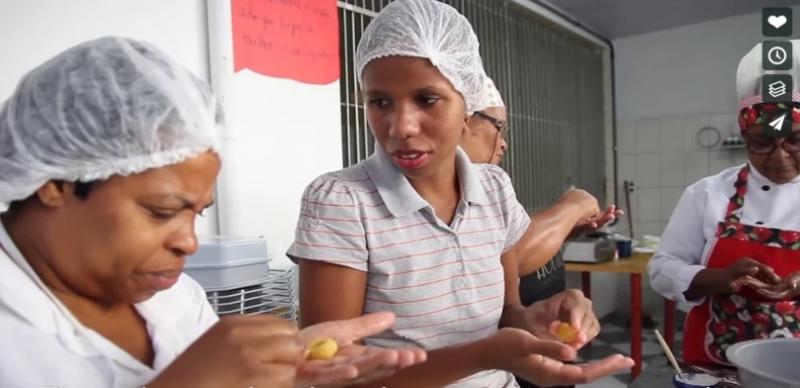
April 2017
Alternative economic systems are possible:
Solidarity Economy in Brazil, Part I
Print and share the two-page PDF version
A number of economists and peace and world security experts have noted the world’s intensifying competition for increasingly scarce natural resources and skyrocketing levels of exclusion and inequality and asked:
Has the current global economic system reached its limits?
To ask such a question launches many people on a search for alternative economic systems to create a more inclusive, equitable, and sustainable world.
One alternative is thriving in Brazil: the “solidarity economy.”
In this first of a three-part examination of the inspirational solidarity economy movement in Brazil, we will look at the beginnings of the movement and its varied members.
As Adriane Ferrarini of the Solidarity Economy and Co-operative Economics Research Group point out, Brazil, and Latin America in general, have a long history of solidarity economy, “beginning with pre-Columbian indigenous forms of production and the collective systems adopted by freed slaves (known as quilombolas in Brazil).” Yet, the sophisticated solidarity economy that we see in Brazil today began less than 30 years.
Economic crises in the 1980s and 1990s
Throughout the 1980s and 1990s, the economy in Brazil lurched from one crisis to the next. More and more people found themselves without paid work and forced into the informal sector to create their own livelihoods. Three of the most common sources of income became, and continue to be, family farming (48 percent of solidarity economic enterprises today), artisan production (23 percent) and selling recyclable materials picked from open air dumps or city streets (four percent). Many communities also created alternative forms of providing credit, banking and microfinance for themselves.
At the same time, the end of the military dictatorship in 1984 and subsequent democratic reforms enabled numerous non-governmental organizations (NGOs) to form and unions to operate. As Daniel Tygel, former executive secretary of the Brazilian Solidarity Economy Forum, points out, the roots of the solidarity economy grew with the support of five sectors:
- Adherents of liberation theology in the Catholic Church, especially those in “pastorals” and grassroots communities;
- Rural unions that helped to unite isolated farmers into associations and cooperatives;
- Non-governmental organizations initially focused on democracy promotion and public participation in politics by promoting “popular cooperatives” in poor neighborhoods;
- Labor unions whose numbers were in decline due to the economic crises expanded their concerns to unemployed people by helping to build worker cooperatives.
- Public universities that created cooperative “incubators” of professors and students helping fledgling economic initiatives

Here Is My Place is a 25-minute documentary by U.S. filmmaker Sarah Garrahan that offers a glimpse into the lives of five women who live in a favela (“slum”) on the outskirts of Rio de Janeiro in Brazil. The baking and skill-share collectives that the women participate in are supported by the Programa Raizes Locais (Local Roots Program), a community-based project run by Associação Brasileira Terra dos Homens, a children and family advocacy NGO which has operated there since 2007 after a study revealed that a large number of the street children in Rio came from the community. Programa Raizes Locais offers theater and capoeira (Brazilian martial arts) classes for children, counseling for pregnant women, and recently formed a women’s baking cooperative. Watch online https://vimeo.com/147332282.
World Social Forum of 2001
A key moment in the early development of the solidarity economy in Brazil was the World Social Forum of 2001. Out of one of the workshops at the forum came three more gatherings to develop the solidarity economy in Brazil.
This was the beginning of the Brazilian Solidarity Economy Forum (FBES), which, with the support of public policy makers, has become the most important and representative impetus behind the consolidation and growth of the movement.
Early on, the FBES studied solidarity economic enterprises and found four essential values and principles:
Self-management: Members have equal decision-making power and participate in important decisions of the enterprise;
Solidarity: Members work toward common goals, fairly distribute opportunities for personal and professional development, improved living conditions and welfare of workers and consumers;
Economic viability: Members carry out the work of the enterprise which is focused on an economic end.
Targeting social and economic needs
People create solidarity economic enterprises in a variety of ways. In many instances, individual farmers, seamstresses, recyclers, artisans, or service providers join with others in the same profession to work as partners, with no bosses or employees. They pool resources to buy needed technologies to gain easier access to credit, such as farmers buying a common tractor.
Sometimes solidarity economic enterprises form spontaneously; other times, support organizations such as the FBES, play a role in bringing workers together.
Often, an existing community, such as indigenous peoples or quilombos (communities originally formed by escaped slaves), decides to take on an economic effort together. Workers from shuttered factories have even been known to take over the property as the site for their newly-formed cooperative.
